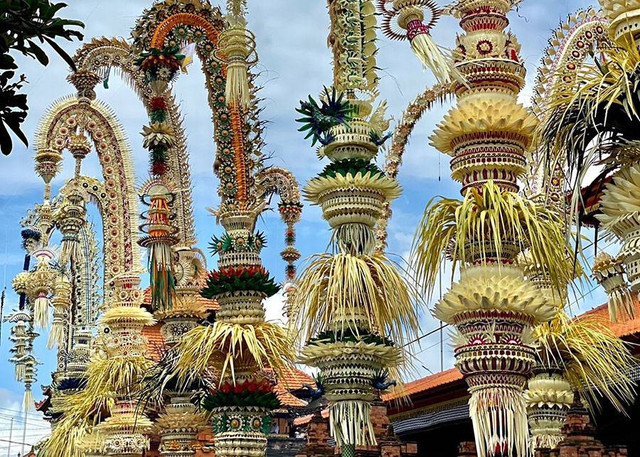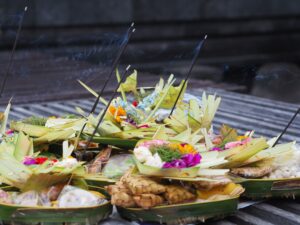Bali’s most significant religious celebration cycle, Galungan & Kuningan, offers wonderful insight into the island’s spiritual heart, especially if you’re fortunate enough to be visiting during this special time. It’s a period when you’ll feel a unique energy across Bali. Additionally, you’ll see beautiful decorations lining the streets and witness families coming together in devotion. With Galungan approaching on Wednesday, April 23, 2025, and Kuningan following ten days later on Saturday, May 3, 2025, now is the perfect time to learn more. As your friendly guides here at Merusaka Nusa Dua, we’d love to answer the question, “What are Galungan 2025 & Kuningan?”. We’ll also share a little about their deep meaning, traditions, and what you might observe as a visitor.
Understanding the Timing: The Pawukon Calendar
First, it helps to know that Galungan and Kuningan don’t follow the standard Gregorian calendar. Instead, their timing depends on the intricate Balinese Pawukon calendar. This unique system cycles every 210 days. Consequently, Galungan and Kuningan occur roughly twice per Gregorian year. After the April/May 2025 celebrations, the next cycle will fall in November 2025. (Note: This differs from Nyepi, the Day of Silence, which follows the Saka lunar calendar).
The Deep Meaning: Celebrating Dharma’s Victory
At its core, Galungan celebrates the victory of Dharma over Adharma. Dharma represents virtue, religious law, righteousness, and the good, while Adharma represents evil, chaos, and injustice. This celebration commemorates a pivotal moment in Balinese spiritual history. Furthermore, it reinforces the belief in the ultimate triumph of good.
Galungan also marks a very special time. The Balinese believe that the spirits of their ancestors descend from the heavens during this period. They visit their former homes and families on Earth. Therefore, it’s a period for families to welcome and honor these ancestral spirits. They express gratitude for their guidance and strengthen family and community bonds through shared prayers and feasts. Kuningan, occurring ten days later, marks the conclusion of this visit, when the ancestors return to the spiritual realm.
Ultimately, this entire celebration deeply connects to Balinese Hindu beliefs. It touches upon cosmology, the importance of ancestors, and the perpetual, dynamic balance between positive and negative forces in the universe.

The beautiful Penjor poles are an iconic symbol of the Galungan celebration in Bali.
The Days Leading Up To Galungan: Preparations and Rituals
The excitement and spiritual preparation build significantly in the days immediately preceding Galungan.
Penyekeban (Sunday, April 20, 2025 – 3 days before) The name relates to “covering” or “ripening.” Spiritually, this day encourages introspection and controlling worldly desires or temptations. It’s like symbolically “covering the ripening bananas” before they spoil. This strengthens oneself against the influence of Adharma. Practically speaking, families begin preparations, often starting to gather ingredients for upcoming offerings and feasts.
Penyajaan Galungan (Monday, April 21, 2025 – 2 days before) “Penyajaan” refers to making jaja. These are traditional Balinese cakes and delicacies used specifically in offerings. Families become busy preparing these special treats. Simultaneously, their spiritual focus continues to build. The atmosphere generally becomes more palpably festive.
Penampahan Galungan (Tuesday, April 22, 2025 – 1 day before) This is a very busy and significant day of preparation.

- Preparing the Feast: Traditionally, families slaughter pigs or chickens on this day. This provides meat for the celebratory feasts and for making elaborate offerings. Community members often prepare dishes like the famous Lawar [link to Balinese Dishes post] together, fostering the gotong royong (mutual cooperation) spirit.
- Erecting the Penjor: Most visibly, Penampahan Galungan is the day when families erect the magnificent Penjor poles outside their homes and businesses.
The Iconic Penjor: Symbol of Prosperity and Gratitude You simply cannot miss the Penjor during the Galungan period! These tall, gracefully arching decorated bamboo poles are one of the most iconic symbols of the celebration. They beautifully line nearly every street, creating a truly breathtaking sight across the island.
- Rich Symbolism: The Penjor holds deep meaning. Its elegant curve represents Mount Agung, Bali’s holiest mountain and believed to be the abode of God. It also symbolizes Naga Basuki, a mythical dragon representing prosperity and welfare. The agricultural products hung on the Penjor – typically rice stalks, coconuts, various fruits (like bananas), root vegetables, and intricate woven coconut leaf ornaments (lamak and sampian) – signify gratitude for the earth’s bounty bestowed by Sang Hyang Widhi Wasa.
- Artistry and Devotion: Each Penjor is essentially a work of art. Families lovingly decorate them, showcasing creativity and devotion. Their widespread presence transforms the island’s appearance, signaling the arrival of this important celebration and filling the streets with festive beauty.
Hari Raya Galungan (The Main Day – Wednesday, April 23, 2025)
Galungan day itself brims with devotion, family connection, and a serene yet celebratory atmosphere.
Morning Prayers and Temple Visits Families typically rise early. They dress in their finest traditional Balinese attire (women in elegant kebaya and sarong, men in sarong, saput, udeng headwear). The day begins with prayers at their household temple (sanggah or merajan). Here, they present elaborate offerings to honor God and the visiting ancestral spirits. Following prayers at home, many families will then visit their community temples (Pura Desa, Pura Puseh, Pura Dalem). They pray together and make further offerings. Consequently, you’ll likely see many people gracefully carrying offerings on their heads as they walk or ride scooters to various temples.
Family Gatherings and Feasting Galungan serves as a crucial time for families to come together. Relatives visit each other’s homes throughout the day. They share special meals, often featuring dishes prepared on Penampahan. They exchange greetings and strengthen familial bonds. It’s truly a day filled with warmth, togetherness, and spiritual reflection.
The Days Between: Umanis Galungan and Beyond
The day immediately following Galungan has its own name: Umanis Galungan (Thursday, April 24, 2025). This day, along with the subsequent days leading up to Kuningan, people still consider part of the holy celebration period. The ancestral spirits are believed to still be visiting their families during this time.
Continuing the Celebration Umanis Galungan is traditionally a day for visiting extended family and friends. It’s a chance to connect with those one might not have seen on Galungan day itself. This practice maintains the festive and social atmosphere. You’ll find many Balinese take time off work during this period. As a result, some local businesses or government offices might be closed or operate on reduced hours, especially around Galungan day. The overall pace of life tends to feel more relaxed and family-focused.
Hari Raya Kuningan (The Culmination – Saturday, May 3, 2025)
Ten days after Galungan comes Kuningan. This important day marks the conclusion of this sacred period and the Galungan festival cycle.
Significance of Kuningan Kuningan Day holds special significance. The Balinese believe this is the time when the ancestral spirits and deities ascend back to the heavens after their visit. It’s therefore a day for final prayers, special offerings, and bidding a respectful farewell until the next cycle.
The Meaning of Yellow (Kuning) The name “Kuningan” derives from the Balinese word kuning, which means “yellow.” This refers to the prominent use of yellow rice (nasi kuning) within the special offerings prepared specifically for this day. In Balinese symbolism, yellow represents prosperity, success, and divinity (often associated with the deity Mahadewa).
Special Kuningan Offerings Besides yellow rice, families prepare unique offerings specific to Kuningan. Common examples include:
- Tamiang: A round, shield-like ornament intricately woven from palm leaf, symbolizing protection and defense against negative forces.
- Kolem: A symbolic container, also made from palm leaf, representing life’s necessities or the vessel of life.
- Endongan: Shaped like a small bag or pouch, symbolizing provisions or supplies (bekal) for the ancestors’ journey back to the spiritual realm.
Morning Rituals Families perform Kuningan prayers and make offerings typically in the morning hours. Rituals should ideally finish before midday (usually before noon). This is because tradition holds that the divine spirits depart around this time. The atmosphere is generally one of hopeful farewell, gratitude for the visit, and blessings received.
Observing Galungan & Kuningan as a Visitor
If your visit coincides with the Galungan and Kuningan period, you have a wonderful opportunity to witness Balinese culture at its most vibrant and authentic. Here’s how you can observe respectfully:
What You’ll See Expect to see the beautiful Penjor poles everywhere – they truly transform the landscape. You’ll notice many Balinese people dressed in stunning traditional clothing, particularly on Galungan and Kuningan days, heading to temples. Temple activity will be higher than usual. You might also encounter occasional religious processions on the roads.
Respectful Etiquette for Observation
- Dress Modestly: If you find yourself near temples during prayer times or if you encounter a ceremony or procession, dressing modestly shows respect. This means covering your shoulders and knees, even if just observing from a distance.
- Don’t Disrupt: Please keep a respectful distance from prayers or ceremonies. Avoid loud noises, intrusive photography (especially flash), or walking through processions or prayer areas. Remember these are deeply spiritual moments for the participants.
- Ask Permission for Photos: Always ask kindly before taking close-up photographs of people, especially those dressed for ceremony or engaged in prayer. A smile and a simple gesture towards your camera usually suffice. Respect their decision if they decline.
- Be Patient: Road closures or traffic slowdowns due to temple processions are common. Practice patience and understanding; the ceremony always takes precedence. Consider it a unique cultural sight!
- Business Hours Awareness: Be aware that some smaller local shops, markets, or businesses might close or have limited hours, especially on Galungan day itself. Major tourist facilities and resorts usually remain open.
- Invitations and Participation: Generally, direct participation in family or temple rituals is for Balinese Hindus. However, observing respectfully from an appropriate distance is usually welcomed. Occasionally, friendly locals might invite you to witness a part of the celebration in their home compound or village. If this happens, consider it a special honor! Accept graciously, ensure you are dressed appropriately (ask if you need help with a sarong/sash), and follow your host’s lead regarding etiquette. A small gift, like fresh fruit, might be appreciated but generally isn’t expected. Our team at Merusaka might also have information on local festivities or special decorations within the resort [link to Merusaka Concierge/Events page?].
A Time of Joy and Reflection
Galungan and Kuningan together form a beautiful and deeply meaningful celebration cycle. It lies at the very heart of Balinese spiritual life. It’s a time that powerfully reaffirms core values: Dharma’s victory over Adharma, the importance of honoring ancestors, the strength of community, and profound gratitude for life’s blessings.
Witnessing even glimpses of this period – the stunning Penjor lining the roads, the devoted families in their finest attire, the air filled with the gentle scent of incense – offers a profound insight into the island’s unique soul. By observing with respect and understanding, your visit during Galungan and Kuningan can become an even more enriching and memorable experience.
We hope this explanation helps you appreciate this special time in Bali.



